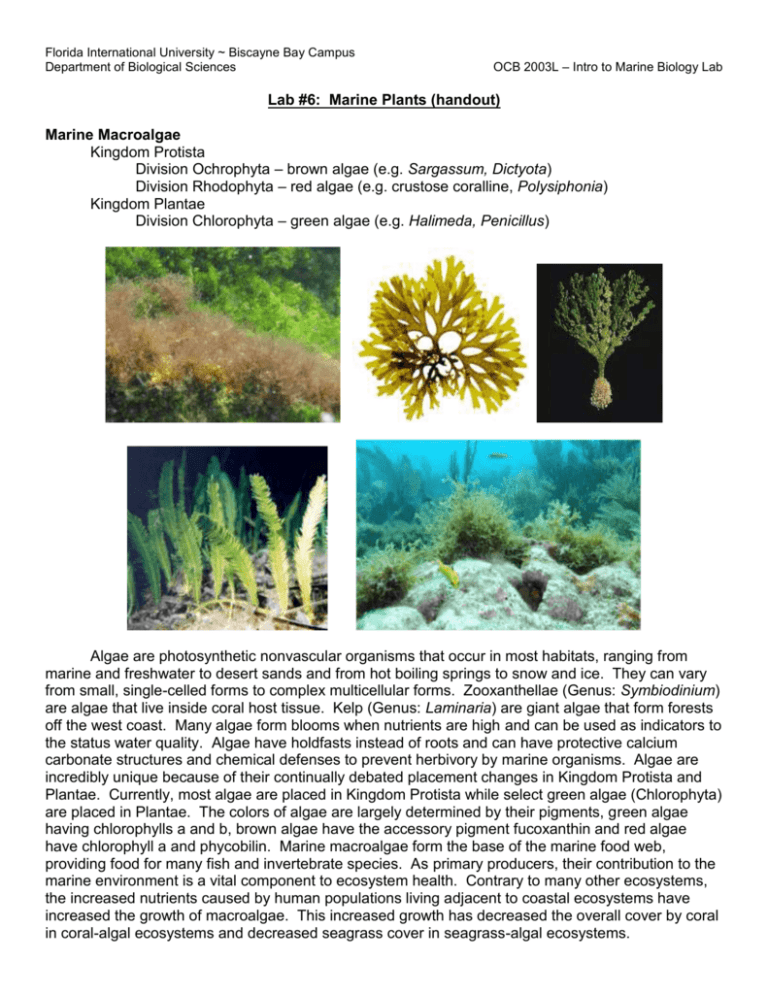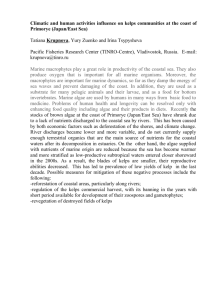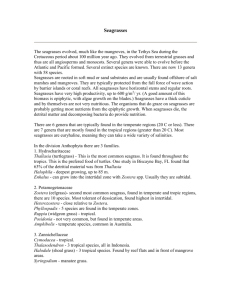Marine Plants - FIU Faculty Websites
advertisement

Florida International University ~ Biscayne Bay Campus Department of Biological Sciences OCB 2003L – Intro to Marine Biology Lab Lab #6: Marine Plants (handout) Marine Macroalgae Kingdom Protista Division Ochrophyta – brown algae (e.g. Sargassum, Dictyota) Division Rhodophyta – red algae (e.g. crustose coralline, Polysiphonia) Kingdom Plantae Division Chlorophyta – green algae (e.g. Halimeda, Penicillus) Algae are photosynthetic nonvascular organisms that occur in most habitats, ranging from marine and freshwater to desert sands and from hot boiling springs to snow and ice. They can vary from small, single-celled forms to complex multicellular forms. Zooxanthellae (Genus: Symbiodinium) are algae that live inside coral host tissue. Kelp (Genus: Laminaria) are giant algae that form forests off the west coast. Many algae form blooms when nutrients are high and can be used as indicators to the status water quality. Algae have holdfasts instead of roots and can have protective calcium carbonate structures and chemical defenses to prevent herbivory by marine organisms. Algae are incredibly unique because of their continually debated placement changes in Kingdom Protista and Plantae. Currently, most algae are placed in Kingdom Protista while select green algae (Chlorophyta) are placed in Plantae. The colors of algae are largely determined by their pigments, green algae having chlorophylls a and b, brown algae have the accessory pigment fucoxanthin and red algae have chlorophyll a and phycobilin. Marine macroalgae form the base of the marine food web, providing food for many fish and invertebrate species. As primary producers, their contribution to the marine environment is a vital component to ecosystem health. Contrary to many other ecosystems, the increased nutrients caused by human populations living adjacent to coastal ecosystems have increased the growth of macroalgae. This increased growth has decreased the overall cover by coral in coral-algal ecosystems and decreased seagrass cover in seagrass-algal ecosystems. Florida International University ~ Biscayne Bay Campus Department of Biological Sciences OCB 2003L – Intro to Marine Biology Lab Key Features Very little belowground root mass Vastly different morphologies for each division, some divisions still uncertain as to Kingdom placement Seagrasses Kingdom Plantae Division Anthophyta – seagrasses, salt marsh and estuarine grass Thalassia (turtle grass) have wide blades; Syringodium (manatee grass) have tubular blades Seagrasses are unique underwater flowering plants with extensive adaptations to live in an aquatic environment. Seagrasses reproduce both sexually and asexually, creating flowers for pollination much like their land relatives as well as sending roots structures into adjacent sand beds for asexual colonization. These seagrass beds are important primary producers in the ecosystem, converting energy from sunlight into foods for fish, turtles, manatees and invertebrates. Also important is the habitat provided by seagrass beds for larval stages of important commercial organisms. Seagrass root structures stabilize the surrounding sand plains, prevent storm surges from reaching the surround coastlines and improving water quality. Seagrass beds are most threatened by prop scars and ship groundings, which excavate large portions of the beds and hurt the health of the surrounding seagrass beds. Key Features Extensive belowground root biomass stabilizes sand to protect coastlines and improve water quality Only underwater flowering plant Mangroves – Flowering terrestrial plants that have reinvaded the fringes of the sea -- 60-75% of the coastline of the earth’s tropical regions is lined with mangroves -- Communities provide refuge from predators, a breeding place, an aid to feeding, ‘nursery’ habitat for a mixture of terrestrial and marine organisms (some endangered) and shoreline stabilization for coastal populations -- Massive mortalities have occurred from typhoons, hurricanes, filling, dredging & channelizing waters, destruction for construction and herbicide use Key Structural Features Shallow roots that spread widely or with peculiar prop roots that stem from the trunk Shallow roots often send up extensions called pneumatophores to the surface of the substrate that allow the roots to receive oxygen in the otherwise anoxic mud Leaves are tough and succulent and have internal water storage tissue Florida International University ~ Biscayne Bay Campus Department of Biological Sciences OCB 2003L – Intro to Marine Biology Lab Some mangroves have elevated salt concentrations and salt glands, which help them maintain the osmotic balance by secreting salt Propagules are specially designed plant seeds that can float in the water for better dispersal Rhizophora mangle (red mangrove) Distinguishing features: reddish colored bark, large prop roots and propagules Mangrove Leaves (red, white, black) Avicennia germinans (black mangrove) Distinguishing features: black colored bark, extensive pneumatophores Florida International University ~ Biscayne Bay Campus Department of Biological Sciences OCB 2003L – Intro to Marine Biology Lab Laguncularia racemosa (white mangrove) Distinguishing features: leaves are silvery on one side, salt glands Conocarpus erectus (buttonwood) Batis maritime (salt wort) Coccoloba uvifera (seagrape)









